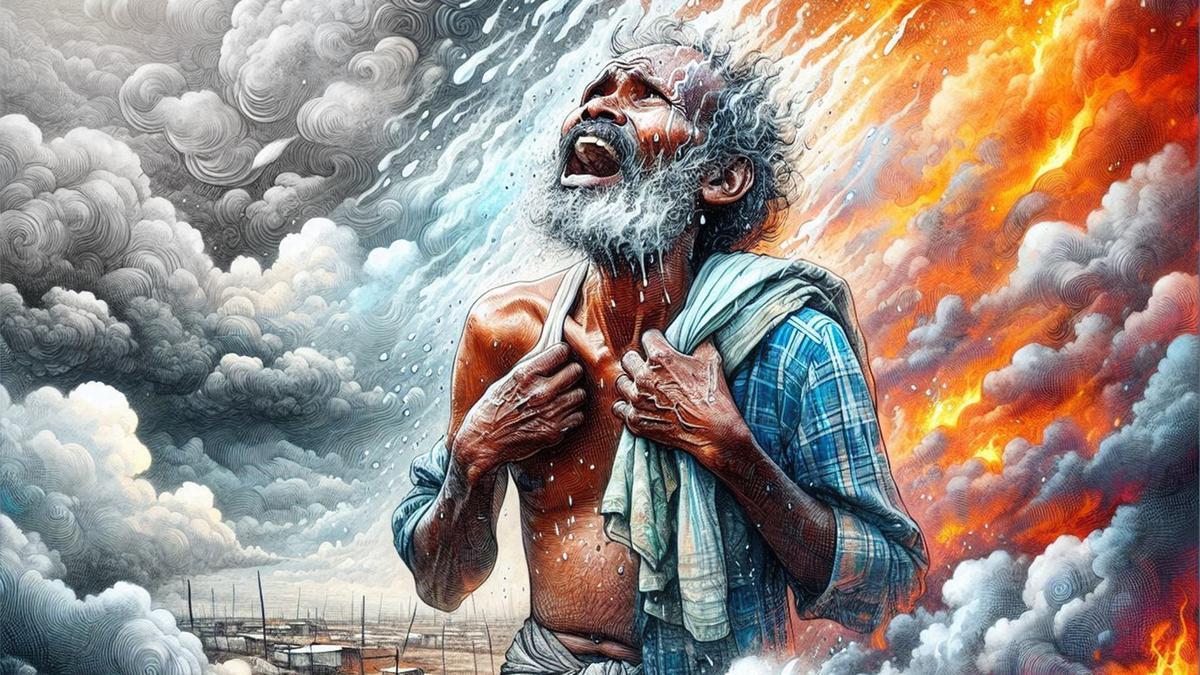
Living with extreme weather | Time to climate-proof lives and livelihoods
The Hindu
With Indian cities and towns becoming increasingly vulnerable to nature’s vagaries, now is the time to climate-proof lives and livelihoods by making informed choices, improving policymaking, and implementing behavioural changes
With his sweat-drenched T-shirt stuck to his body, Anup Majhi, 37, pauses for a moment beneath the AC blowers in the bus parked in Kolkata’s Esplanade area. A small-time salesman selling pills and potions, Majhi has been hopping on and off buses plying on the 180-km stretch between Esplanade and Digha for the past 26 years.
“Two tablets during the day and two at night, and you will be rid of indigestion or gas,” he promises his customers. In the roughly 10 minutes he spends on the bus, he manages to sell a bottle of pills. On a busy day, Majhi makes a profit of ₹3,000. The sole earning member in his family of four, he has never taken beyond a few days off from work at a stretch. Last month, for the first time, Majhi took a whole month off. The reason: to avoid exhaustion due to the extreme heat. “The moment I would step out of the AC bus, my skin would start burning. I kept falling ill. I incurred a major loss taking a month off. But I have the rest of my life to earn money. If I keep getting sick, there is no point going to work,” he says. He was lucky his family supported him. “They were insistent that I should not go out in this heat.”
From March 1 to June 18 this year, 110 people died due to heatstroke in India, according to data from the Health Ministry. In several places, including New Delhi, maximum temperatures touched nearly 50 degrees Celsius, a record high for the month of June. The capital has banned work on construction sites between noon and 3 p.m., and several hospitals have opened heat stroke wards. The 2023-24 El Nino has been one of the five strongest on record resulting in above-normal temperatures almost everywhere, making 2023 the warmest year on record.
Informal sector workers such as Majhi, who make up 90% of India’s workforce, are the most susceptible to such climate-related emergencies. According to a World Bank study, India might account for nearly 43% of global job losses from heat stress-associated productivity declines by 2030. The ripple effect from weather-related loss of livelihood is bound to spread far and wide, with people across socio-economic strata being affected over time.
The Central government’s Climate Vulnerability Assessment report for 2019-20 had pointed out that all States in India are significantly climate vulnerable. How then can we climate-proof the economy? This will require transforming livelihood sectors and preparing for multi-hazardous conditions rather than single hazards/events, observes Chandni Singh, senior researcher at Indian Institute for Human Settlements and lead author of Intergovernmental Panel on Climate Change’s (IPCC) most recent climate report. “This will involve planning for where we work and under what conditions, climate-proofing certain infrastructure and at-risk sectors, providing safety nets for contract labour and insurance incentives for the most exposed,” she says.
For Om Prakash Dubey, a cab driver based in Kolkata, driving has become a chore over the past few months. “I cannot bear the humidity this year. When I’m ferrying passengers and the AC is switched on, it is bearable. I’m trying to cut down on my driving hours, and have my meals on time. My health has deteriorated this year due to the extreme heat. But what can I do?” says the 53-year-old.
Sanjay Lodhi from Uttar Pradesh works in Gujarat’s Changodar making number plates of cars for 12 hours a day. He tells me over phone that he is returning to his village in Unnao after suffering severe heat exhaustion this month. He was hospitalised for four days due to dehydration. His views echo Majhi’s: if he is healthy, he can work in the months ahead. “My colleagues at the factory are also falling sick. It is in my interest that I go back home till the weather changes. I am not returning for another two months at least,” he says.











